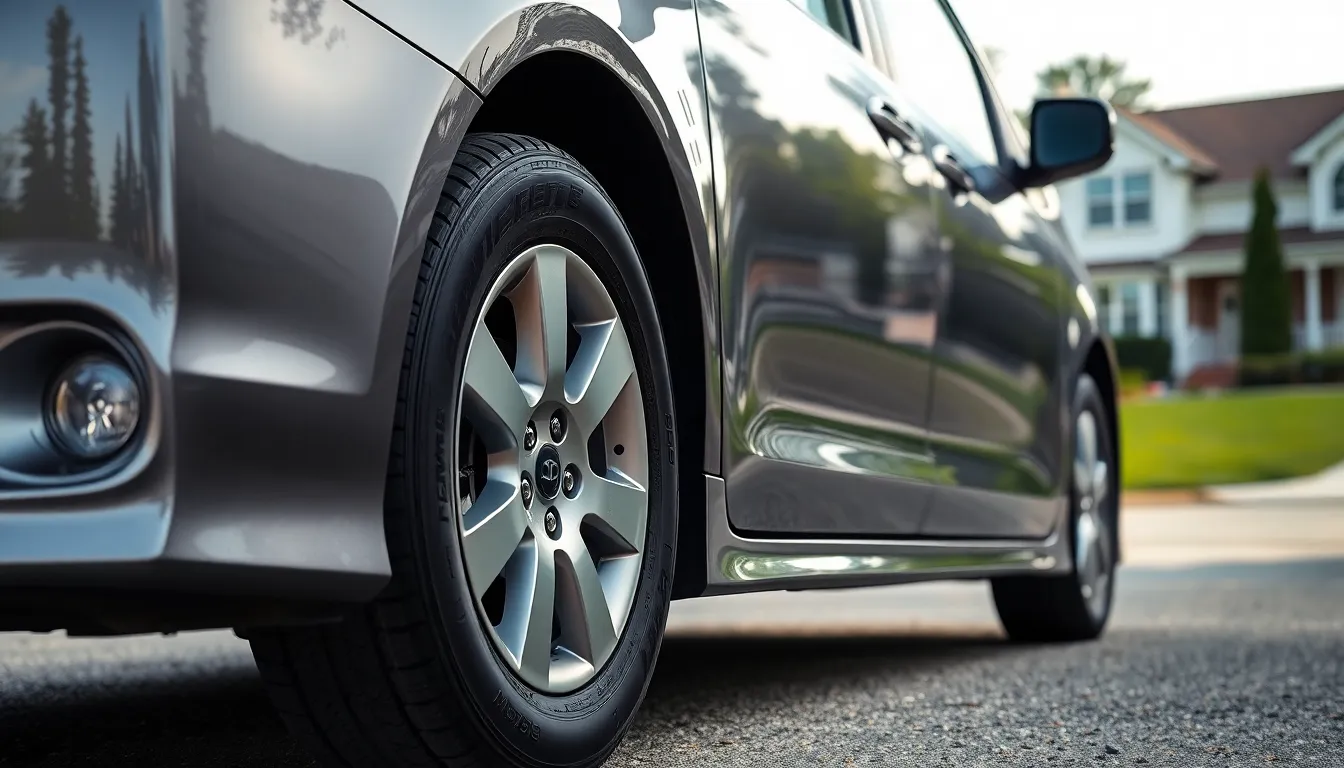We know how confusing it can be when you’re standing in the tire shop wondering which size fits your Toyota Sienna. With multiple generations and trim levels each requiring different specifications you’re not alone in feeling overwhelmed by the choices.
Your Sienna’s tire size isn’t just about getting from point A to point B—it’s about safety performance and maintaining your vehicle’s warranty. The wrong size can affect everything from your speedometer accuracy to your van’s handling characteristics especially when you’re carrying a full load of family and cargo.
We’ve compiled everything you need to know about Toyota Sienna tire sizes across all model years. Whether you’re driving a 2004 first-generation model or the latest hybrid version we’ll help you decode those numbers on your sidewall and choose the perfect replacement tires for your exact needs.
Understanding Toyota Sienna Tire Size Specifications
Toyota Sienna tire size specifications follow a standardized numbering system that tells us everything we need to know about our van’s tire dimensions. The three-digit format includes tire width, aspect ratio, and wheel diameter measurements that manufacturers encode on every tire sidewall.
Reading the tire size becomes straightforward once we understand each component of the alphanumeric code. The first number represents tire width in millimeters, measuring from sidewall to sidewall. Following this width measurement, we find the aspect ratio expressed as a percentage of the tire’s width. The final number indicates the wheel diameter in inches that the tire fits.
Most Toyota Sienna models use tire sizes ranging from 215/65R16 to 235/60R18 depending on the model year and trim level. Base models typically feature smaller 16-inch wheels, while higher trim levels come equipped with larger 17-inch or 18-inch wheel configurations. Limited and Platinum trims often include the largest wheel sizes for enhanced appearance and performance characteristics.
| Toyota Sienna Generation | Standard Tire Size | Optional Tire Size | Wheel Diameter |
|---|---|---|---|
| First Generation (2004-2010) | 215/70R16 | 225/60R17 | 16-17 inches |
| Second Generation (2011-2020) | 235/60R17 | 235/55R18 | 17-18 inches |
| Third Generation (2021-Present) | 235/60R18 | 235/55R19 | 18-19 inches |
Load index and speed rating appear after the tire size designation and provide crucial safety information for our Sienna. Load index numbers correspond to maximum weight capacity per tire, typically ranging from 95 to 103 for Sienna applications. Speed ratings use letters to indicate maximum safe operating speeds, with most Sienna tires carrying H or V ratings.
Temperature grades A, B, or C indicate the tire’s ability to dissipate heat under controlled conditions. Traction grades AA, A, B, or C represent the tire’s stopping ability on wet pavement during standardized tests. These specifications help us select replacement tires that match our driving conditions and performance expectations.
Standard Tire Sizes by Model Year

Toyota Sienna tire sizes vary significantly across four distinct generations spanning over 25 years. Each generation features exact tire size configurations that match the vehicle’s design and performance requirements.
First Generation (1998-2003)
First generation Toyota Sienna models used smaller tire configurations compared to later models. Standard tire sizes included 205/70R15 and 215/65R15 for the 1998-2001 model years. The 2002-2003 models maintained similar dimensions with 215/65R15 being the most common specification across all trim levels.
Second Generation (2004-2010)
Second generation Sienna models introduced larger wheel diameters with enhanced tire options. Standard configurations included 215/65R16 and 225/60R17 across the model range. Some trim levels featured 225/65R17 tires to accommodate different suspension setups and performance characteristics.
Third Generation (2011-2020)
Third generation models expanded tire size options with distinct specifications for different trim levels. Base model Siennas typically came equipped with 235/60R17 tires for optimal comfort and fuel efficiency. Upper trim levels featured 235/55R18 tires from 2011 through 2019. The 2020 model year maintained these same size specifications with 235/60R17 for base models and 235/55R18 for higher trim configurations.
Fourth Generation (2021-Present)
Fourth generation Sienna models offer the most diverse tire size options across trim levels and drivetrain configurations. Here’s the complete breakdown:
| Trim Level | FWD Configuration | AWD Configuration |
|---|---|---|
| LE | 235/65R17 | 235/55R18 |
| XLE | 235/60R17 | 235/55R18 |
| SE | 235/50R19 | 235/50R19 |
| Limited | 235/55R18 | 235/55R18 |
| Platinum | 235/60R18 | 235/60R18 |
Current generation models feature different tire sizes based on both trim level and drivetrain selection. Front wheel drive configurations often use different specifications than all wheel drive variants across LE and XLE trim levels.
Tire Size Code Breakdown and Meaning
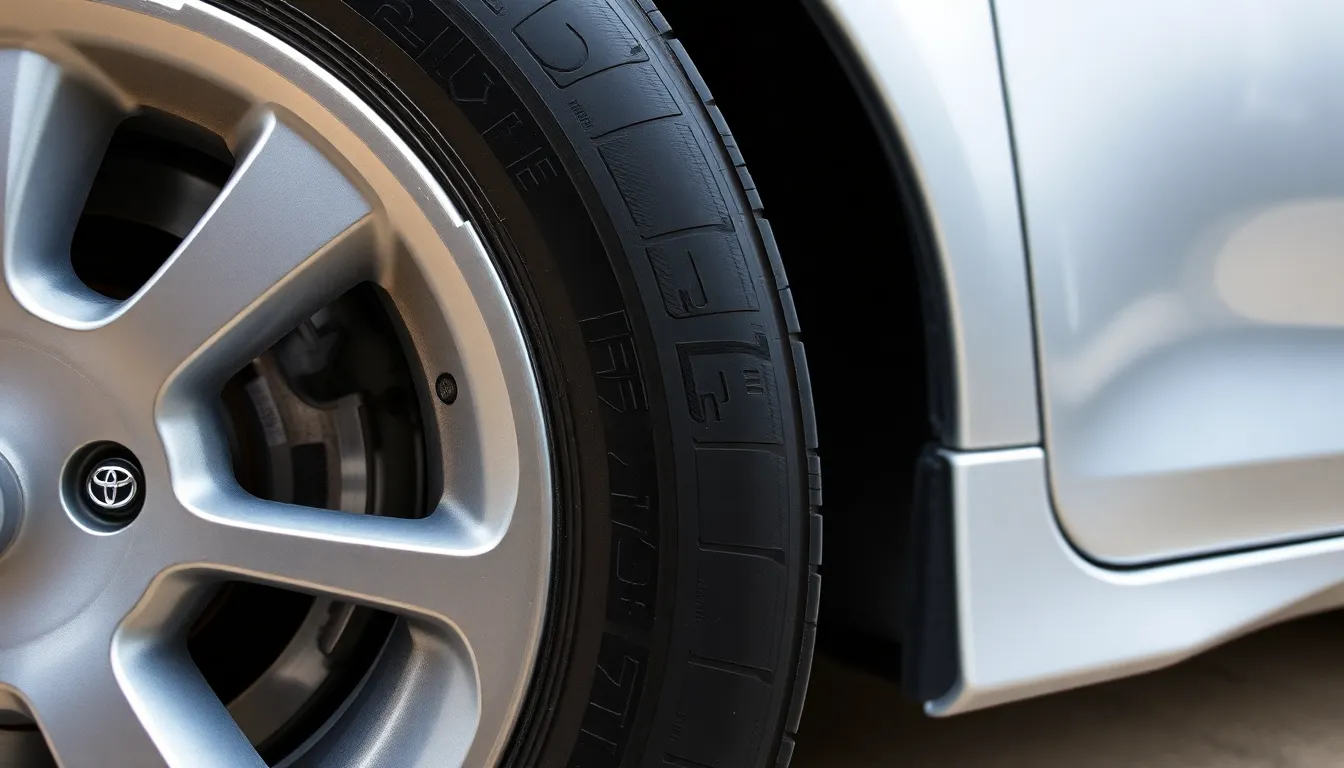
Understanding Toyota Sienna tire size codes becomes straightforward once we decode each component of the alphanumeric sequence. The tire sidewall displays information in a standardized format that applies universally across all tire manufacturers and vehicle brands.
Width (First Number): The initial three digits represent tire width measured in millimeters from sidewall to sidewall. Toyota Sienna models commonly use widths ranging from 205mm to 235mm, with newer generations typically featuring wider tires like 235mm for enhanced stability and road contact.
Aspect Ratio (Second Number): Following the forward slash, this percentage indicates sidewall height relative to tire width. Common Sienna aspect ratios include 70, 65, 60, 55, and 50, where lower numbers create shorter sidewalls and improved handling response.
Construction Type (Letter): The “R” designation stands for radial construction, which describes how tire cords run perpendicular to the direction of travel. All modern Toyota Sienna tires use radial construction for better fuel economy and longer tread life.
Rim Diameter (Final Number): The last digits specify wheel diameter in inches, ranging from 15 inches on older Sienna models to 19 inches on performance oriented trims like the SE variant.
| Tire Size Component | Toyota Sienna Examples | Function |
|---|---|---|
| Width (mm) | 205, 215, 235 | Contact patch width |
| Aspect Ratio (%) | 70, 65, 60, 55, 50 | Sidewall height percentage |
| Construction | R (Radial) | Internal cord arrangement |
| Rim Diameter (in) | 15, 16, 17, 18, 19 | Wheel size compatibility |
Reading these codes correctly ensures proper fitment for your exact Toyota Sienna configuration. The 2025 Sienna LE uses 235/65R17 tires, meaning 235mm width, 65% aspect ratio, radial construction, and 17-inch rim diameter. Different trim levels like the Limited and Platinum variants use 235/60R18 specifications for enhanced performance characteristics.
Earlier Sienna generations from 2000 employed smaller configurations such as 205/70R15 and 215/65R15, reflecting the vehicle’s evolution toward larger wheel diameters and wider tire profiles. These dimensional changes directly impact ride quality, handling precision, and overall vehicle dynamics across different model years.
OEM vs Aftermarket Tire Options

We’ll explore how original equipment manufacturer specifications compare with aftermarket alternatives to help you make informed decisions about your Toyota Sienna’s tire replacement needs.
Original Equipment Manufacturer Recommendations
Toyota engineers design exact tire dimensions for each Sienna trim level to optimize performance, safety, and fuel efficiency. Base and LE trims from 2021 to 2025 models typically use 235/65R17, 235/60R17, or 235/55R18 configurations depending on the exact model year. Limited and Platinum trims usually feature 235/60R18 tires for enhanced ride comfort and handling characteristics.
SE and higher performance trims with all-wheel drive variants often require 235/50R19 or 235/50R20 tires for sportier driving dynamics. The 2025 Toyota Sienna LE uses 235/65R17 specifications, while Limited and Platinum AWD versions run on 235/60R18 configurations to maintain proper vehicle calibration.
OEM tires include exact load indexes ranging from 102 to 103 and speed ratings between T and V classifications. These specifications ensure proper integration with the vehicle’s suspension geometry, braking system calibration, and electronic stability controls. Toyota’s original equipment maintains warranty coverage and guarantees optimal performance across all driving conditions.
Popular Aftermarket Alternatives
Aftermarket tire manufacturers produce compatible options that match OEM dimensions while offering different price points and performance characteristics. Firestone FT140 models provide cost-effective alternatives for standard driving needs, while Bridgestone Turanza LS100 A tires offer enhanced comfort and longevity for frequent highway use.
| Brand | Popular Models | Compatible Sizes | Key Features |
|---|---|---|---|
| Firestone | FT140 | 235/65R17, 235/60R18 | Budget-friendly, reliable performance |
| Bridgestone | Turanza LS100 A | 235/55R18, 235/60R18 | Enhanced comfort, low road noise |
| Michelin | Various models | All OEM sizes | Premium quality, extended tread life |
| Continental | Multiple options | 235/65R17, 235/50R19 | All-season capability, wet traction |
Aftermarket selections must match or exceed OEM load ratings and speed classifications to maintain safety standards. Buyers choosing 235/65R17, 235/60R18, or 235/55R18 aftermarket tires maintain proper vehicle dynamics when specifications align with original equipment requirements. Quality aftermarket options provide comparable performance at potentially lower costs while preserving essential safety margins through proper load index and speed rating compliance.
Performance Considerations for Different Tire Sizes

Selecting the appropriate tire size for your Toyota Sienna directly impacts three critical performance areas that affect your daily driving experience. Different configurations create distinct trade-offs in fuel efficiency, comfort levels, and load-bearing capabilities.
Fuel Economy Impact
Larger tire sizes reduce fuel efficiency due to increased rolling resistance and weight. The 235/60R18 configuration used on Limited and Platinum trims creates more surface contact with the road compared to the standard 235/65R17 size, resulting in higher fuel consumption during highway driving.
Rolling resistance increases by approximately 10-15% when upgrading from 17-inch to 18-inch wheel configurations. Drivers using the SE trim’s 235/50R19 setup experience the most important fuel economy reduction, with efficiency dropping by 2-3 MPG compared to base trim levels.
Weight differences between tire sizes also contribute to fuel consumption variations. The 235/65R17 configuration weighs approximately 4-6 pounds less per tire than the 235/50R19 setup, creating measurable differences in acceleration and braking performance.
Ride Comfort and Handling
Smaller profile tires like the 235/50R19 configuration provide superior handling precision but compromise ride comfort over rough surfaces. The reduced sidewall height transmits more road imperfections directly to the cabin, creating a firmer driving experience.
Larger sidewall configurations such as 235/65R17 absorb road irregularities more effectively, delivering smoother ride quality during city driving and highway cruising. These tires flex more readily over potholes and expansion joints, reducing impact harshness for passengers.
Cornering performance improves with lower profile tires due to reduced sidewall flex during steering inputs. The 235/55R18 configuration used on AWD models balances handling responsiveness with acceptable comfort levels, making it suitable for families prioritizing both dynamics and passenger comfort.
Load Capacity Requirements
Tire load ratings must accommodate the Sienna’s maximum payload capacity of 1,560 pounds plus passenger weight. Each tire size carries exact load index ratings that determine safe weight limits per tire.
The 235/65R17 configuration typically features a load index of 103, supporting 1,929 pounds per tire at maximum inflation pressure. Higher trim levels using 235/60R18 or 235/50R19 sizes maintain similar load capacities through reinforced construction methods.
Proper load distribution becomes critical when approaching maximum capacity with cargo or eight passengers. Underinflated tires reduce load capacity by 10-20%, making regular pressure monitoring essential for maintaining safety margins during fully loaded trips.
Seasonal Tire Recommendations
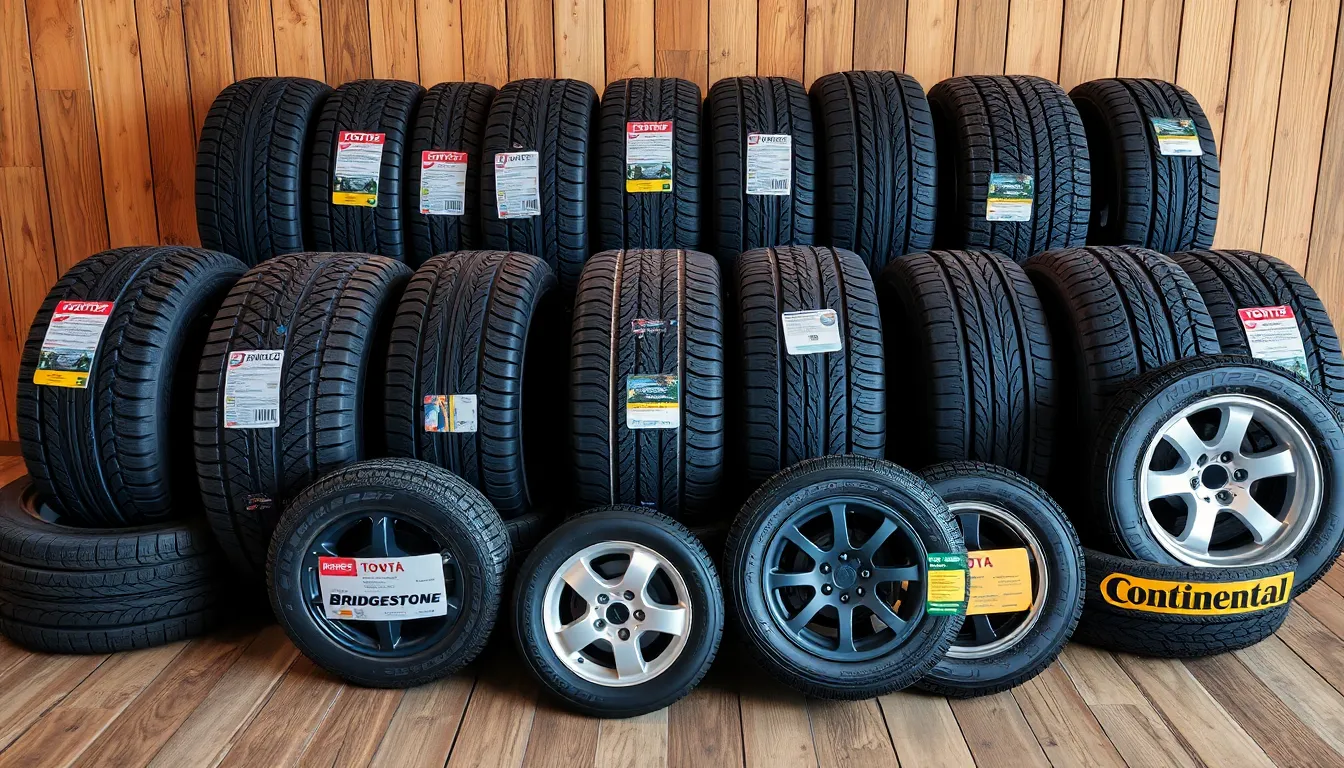
Seasonal tire selection significantly impacts your Toyota Sienna’s performance across different weather conditions. We’ve identified the most effective tire options for each season based on the exact requirements of your van’s size configurations.
All-Season Tire Options
Bridgestone Turanza LS100 A delivers exceptional handling and comfort for Limited trim models equipped with P235/60R18 tires. This tire combines responsive steering with reduced road noise for family-friendly driving experiences.
Firestone FT140 provides optimal performance for LE trim Siennas using P235/65R17 configurations. The tire balances durability with cost effectiveness while maintaining consistent traction across various road surfaces.
Michelin Primacy LTX stands out for its superior traction capabilities across multiple Sienna trim levels. This tire excels in wet conditions and offers extended tread life for families who prioritize long-term value.
Continental CrossContact LX20 fits SE models with 235/50R19 specifications perfectly. The tire enhances cornering stability while preserving the comfortable ride quality essential for passenger vans.
Winter Tire Considerations
Michelin X-Ice delivers outstanding grip on snowy and icy surfaces for all Toyota Sienna configurations. The tire’s advanced rubber compound maintains flexibility in temperatures below 45°F for consistent winter performance.
Continental WinterContact SI offers superior handling control during harsh winter conditions. This tire reduces stopping distances on ice by up to 25% compared to all-season alternatives while maintaining quiet operation.
Nokian Hakkapeliitta excels in extreme winter environments with deep snow and persistent ice conditions. The tire features specialized tread patterns that evacuate snow effectively while providing dependable traction for loaded vans.
Bridgestone Blizzak WS90 accommodates various Sienna tire sizes from 235/65R17 to 235/50R19. The tire’s unique tread design maximizes contact with icy surfaces while preserving fuel efficiency during winter months.
Cost Analysis and Budget Planning
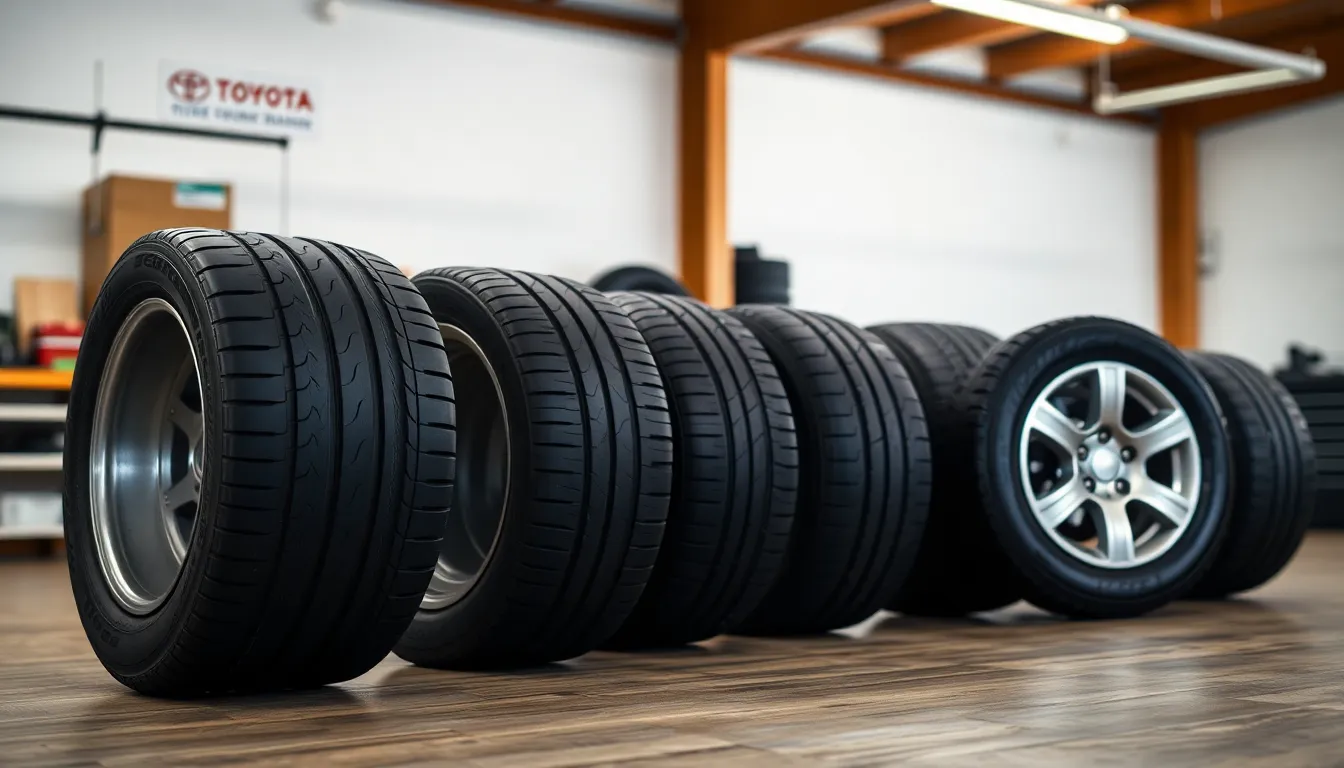
Planning our Toyota Sienna tire budget involves understanding how different tire sizes impact overall costs. The size specifications directly affect pricing, with larger configurations like 235/50R19 for SE trims costing significantly more than standard 235/65R17 options for LE models.
Initial Purchase Costs by Tire Size
Different Sienna tire sizes create varying price points across our budget planning. Premium sizes for Limited and Platinum trims with 235/60R18 specifications typically cost 15-25% more than base LE configurations. Performance-oriented 235/50R19 tires for SE models command the highest prices due to their specialized construction and lower production volumes.
| Tire Size | Trim Level | Price Range per Tire | Annual Set Cost |
|---|---|---|---|
| 235/65R17 | LE FWD | $120-$180 | $480-$720 |
| 235/60R17 | XLE FWD | $130-$200 | $520-$800 |
| 235/55R18 | Limited AWD | $150-$240 | $600-$960 |
| 235/60R18 | Platinum | $160-$250 | $640-$1,000 |
| 235/50R19 | SE | $180-$300 | $720-$1,200 |
Maintenance and Service Budgeting
Regular tire maintenance extends replacement intervals and reduces long-term costs for our Sienna ownership. Rotation services every 5,000 to 8,000 miles cost approximately $50-$80 per session but can extend tire life by 20-30%. Wheel alignment checks twice annually prevent uneven wear patterns that force premature replacement.
Tire pressure monitoring adds minimal cost but prevents damage from underinflation. Monthly pressure checks using a quality gauge cost nothing but save hundreds in premature replacement expenses. Seasonal storage for winter tire sets adds $100-$200 annually but protects our investment in specialized tires.
Long Term Replacement Planning
Toyota Sienna tires typically last 60,000 to 80,000 miles under normal driving conditions. Higher-profile configurations like 235/65R17 often achieve longer wear intervals than low-profile 235/50R19 options due to thicker sidewalls and reduced road impact stress. AWD models experience slightly faster wear due to power distribution differences.
Budget allocation strategies help manage replacement timing across our ownership period. Setting aside $15-$25 monthly creates adequate reserves for standard tire sizes, while premium configurations require $25-$40 monthly savings. Emergency replacement funds covering two tires help address unexpected damage from road hazards.
Brand Selection Impact on Budgets
OEM tire brands like Bridgestone and Firestone offer guaranteed compatibility with our Sienna specifications. Premium options from Michelin and Continental cost 20-40% more but deliver extended mileage warranties up to 80,000 miles. Budget-friendly alternatives can reduce initial costs by 30-50% while meeting safety requirements.
Warranty coverage varies significantly across price ranges and affects our total cost calculations. Premium tires often include road hazard protection and pro-rated replacement guarantees that offset higher purchase prices. Budget options typically offer limited warranty coverage requiring careful evaluation of actual value.
Installation and Maintenance Tips
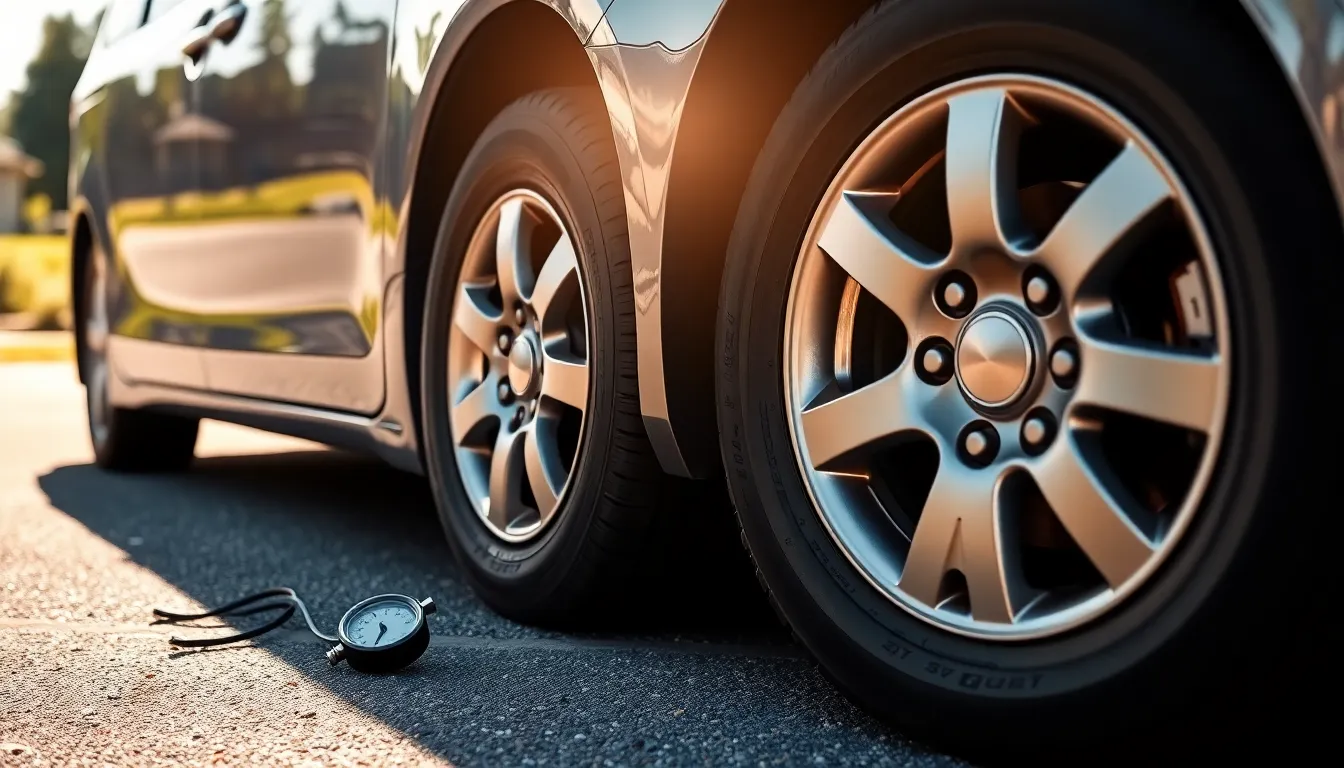
Regular maintenance ensures your Toyota Sienna’s tires perform optimally throughout their lifespan. We recommend checking tire pressure monthly using a digital gauge to maintain the manufacturer’s specified PSI ratings for each trim level.
Proper Installation Procedures
Professional installation guarantees correct mounting and balancing for your exact Sienna tire size. Mount 235/60R17 tires on LE models with torque specifications of 76-83 ft-lbs for wheel nuts. Balance wheels within 0.25 ounces to prevent vibration at highway speeds.
Pressure Monitoring Systems
Check inflation levels every 30 days to maintain optimal performance across all Toyota Sienna configurations. Monitor 235/55R18 tires on Limited AWD models at 36 PSI front and 35 PSI rear for balanced handling. Verify 235/50R19 SE model pressures monthly since larger wheels lose air faster than standard configurations.
Rotation and Alignment Schedule
Rotate tires every 5,000-7,500 miles following Toyota’s recommended pattern for your drivetrain configuration. Front-wheel-drive Siennas require different rotation patterns than all-wheel-drive models due to power distribution differences. Schedule alignment checks annually or after hitting important potholes to prevent uneven wear.
Inspection and Safety Checks
Examine tread depth using the penny test method every month to identify wear patterns early. Replace tires when tread depth reaches 2/32 inch on any Toyota Sienna model to maintain traction safety. Inspect sidewalls for cracks or bulges that indicate structural damage requiring immediate replacement.
Seasonal Maintenance Requirements
Switch between all-season and winter tires based on regional climate conditions for optimal Sienna performance. Store off-season tires in cool, dry locations away from direct sunlight to prevent rubber degradation. Clean wheels thoroughly when changing seasonal tires to remove salt and debris buildup.
| Maintenance Task | Frequency | All Trims | AWD Models |
|---|---|---|---|
| Pressure Check | Monthly | Required | Required |
| Tire Rotation | 5,000-7,500 miles | Standard Pattern | Modified Pattern |
| Alignment Check | Annually | Recommended | Essential |
| Tread Inspection | Monthly | 2/32″ minimum | 2/32″ minimum |
Conclusion
We’ve covered everything you need to know about selecting the right tire size for your Toyota Sienna. From understanding the complex numbering system to choosing between OEM and aftermarket options, proper tire selection directly impacts your van’s safety, performance, and fuel efficiency.
Remember that your exact model year and trim level determine the exact tire size you’ll need. Whether you’re driving a base LE with 235/65R17 tires or a performance-oriented SE with 235/50R19 configurations, matching the correct specifications ensures optimal handling and maintains your vehicle’s warranty coverage.
Regular maintenance including pressure checks, rotations, and seasonal tire changes will maximize your investment. By following our guidelines for installation, maintenance, and budget planning, you’ll keep your Sienna running safely and efficiently for years to come.
Frequently Asked Questions
What tire sizes does the Toyota Sienna use?
Toyota Sienna tire sizes vary by generation and trim level. Common sizes include 215/65R16, 225/60R17, 235/60R17, 235/55R18, and 235/50R19. The first generation (1998-2003) used smaller configurations like 205/70R15, while newer models (2021-present) offer diverse options ranging from 235/65R17 for base trims to 235/50R19 for SE models.
How do I read Toyota Sienna tire size codes?
Tire size codes follow a standardized format. For example, in 235/60R17: 235 represents tire width in millimeters, 60 is the aspect ratio (sidewall height as percentage of width), R indicates radial construction, and 17 specifies rim diameter in inches. Understanding these numbers helps ensure proper fitment for your specific Sienna model and year.
Can I use different tire sizes on my Toyota Sienna?
While aftermarket alternatives exist, you should stick to OEM specifications or equivalent sizes that match load ratings and speed classifications. Using incorrect tire sizes can affect speedometer accuracy, handling, fuel efficiency, and vehicle warranty. Always consult your owner’s manual or tire placard for approved sizes specific to your trim level.
What’s the difference between OEM and aftermarket Sienna tires?
OEM tires are designed by Toyota engineers to optimize performance, safety, and fuel efficiency for each trim level. Aftermarket options like Firestone and Bridgestone offer compatible alternatives at different price points while maintaining safety standards. Aftermarket tires must meet or exceed OEM load ratings and speed classifications to ensure proper performance.
How do tire sizes affect Toyota Sienna performance?
Larger tire sizes like 235/60R18 may reduce fuel efficiency due to increased rolling resistance but provide better stability. Smaller profile tires like 235/50R19 offer improved handling but may compromise ride comfort. Each size is engineered to balance performance, comfort, and load-bearing capabilities specific to different trim levels and driving conditions.
What are the best all-season tires for Toyota Sienna?
Popular all-season options include Bridgestone Turanza LS100 A for Limited trims and Firestone FT140 for LE trims. These tires balance performance and cost while meeting OEM specifications. For winter conditions, consider Michelin X-Ice or Continental WinterContact SI for superior grip and handling in icy conditions.
How much do Toyota Sienna tires cost?
Tire costs vary significantly by size and brand. Larger configurations like 235/50R19 for SE trims are more expensive than standard sizes like 235/65R17 for LE models. Budget planning should consider initial purchase costs, brand selection, warranty coverage, and long-term replacement schedules to manage overall tire expenses effectively.
How often should I replace Toyota Sienna tires?
Tire replacement depends on driving conditions, maintenance, and tire quality. Regular maintenance including monthly pressure checks, rotation every 5,000-7,500 miles, and annual alignment checks can extend tire life. Monitor tread depth and sidewall condition regularly, and replace tires when tread depth reaches 2/32 inches or shows signs of uneven wear.

